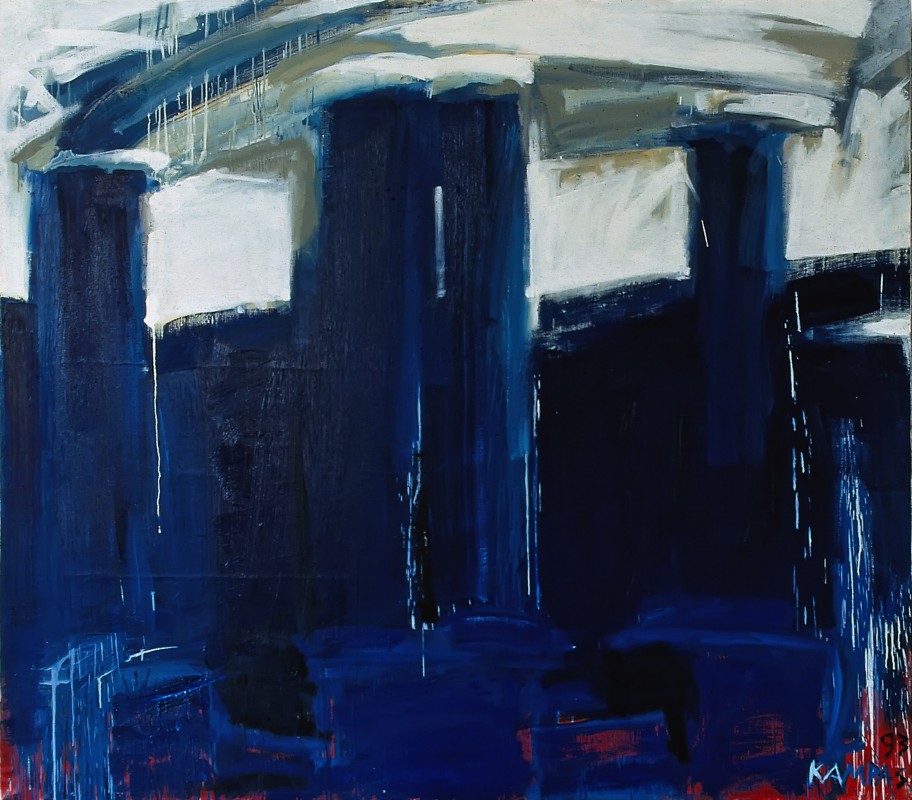Rimvidas Jankauskas-Kampas (1957-1993)
Almost every author writing about the persona and creative work of Rimvidas Jankauskas-Kampas mentions the atmosphere of Kaunas and Vilnius of the 1970s and 80s in their memories. Indeed, Jankauskas-Kampas is a very influential example of a different lifestyle of that time. In the 80s Kaunas he was one of the students at Kaunas Steponas Žukas technical college of applied fine arts, who at the time were quite different from the common people. That also shows in photographs: long hair, being silly in front of the camera, wide smiles, all that was in contrast to the grey uniform masses that we imagine were present in the second largest city of Lithuania during the Soviet years. The 1980s linked the life of Kampas to another Lithuanian art institution, the only institution of higher education where one could study arts, Vilnius Academy of Arts (Vilnius Arts Institute at the time).
The painter then returned to Kaunas for the second time after his studies in Vilnius and it may be said that is when, after his return, he reached the highest altitudes of creative energy that was also a peculiar beginning of the end. Certainly, the second Kaunas period is when he spent the last five years of his life (1988-1993) creating such paintings that did and still do have a great effect on the audience.
During this stage everybody remembers and singles out the now closed synagogue space at the foot of Žaliakalnis hill (Kaunas Hasidic synagogue, built at the end of the 19th century at the intersection of Gimnazijos and Antanas Mackevičius streets) where the painter found shelter for a while. Now it may seem like underground, an exotic experience or some vivid colours in his story, but at the time the young painter truly struggled, had nowhere to stay and nowhere to create, paint. The synagogue space then belonged to the Kaunas Faculty of Vilnius Academy of Arts (and still does) and Jankauskas-Kampas’ colleagues, sculptors, lecturers of the academy, students had their workshops there. Kampas settled beside them, the difference being that he would not only come to work, like the others did, but also laid his head next to his works.
This was probably the most influential and the most emotionally solid environment for his creative work, both physically and spiritually, that produced some of his most popular works, “Goodbye Sinangogue” (1991) and “Abandoned Synagogue” (1993). Art historian Raminta Jurėnaitė wrote about that special place: “
“During one such action [speaking about visits to the painters’ workshop – A/N] I made my way to Kaunas, to visit Aistė Ramūnaitė, Arūnas Vaitkūnas and Augis Varkulevičius. Our day ended at Kampas’ place. He got a place to do his work in an inactive synagogue. The interior was almost entirely empty. The blue walls had a lot of ongoing and finished works leant against them, vivid colours burning like torches. The sojourner had dedicated one corner of the interior to Marxist writings that he found here, intended for waste paper, and cordoned it off with a rope. The large space was unheated and Kampas had built an enclosure/house from larger canvases to save his shrammed bones from the cold and for sleep (…)”.
The story became popular after the painter’s death, while his circle of fans was expanding after they have seen his works in exhibitions. After finding his own motifs, themes and special broad strokes, Jankauskas-Kampas seemingly ended one creative stage, did a show at the Kaunas Picture Gallery and could have moved on. However, this stage became his last. We will never know what worlds of modern painting were left unexplored by him.
Back to the map

